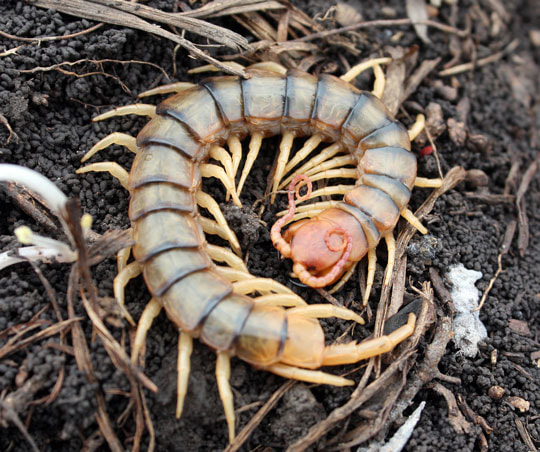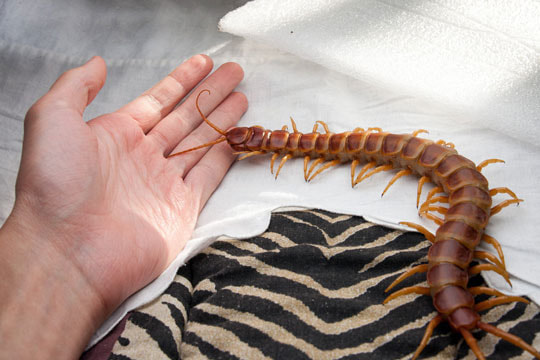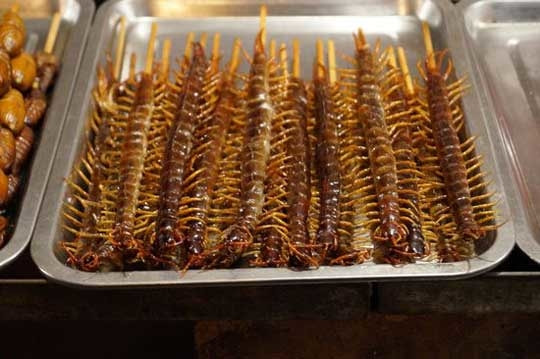|
You may have noticed that the business end of the weapon on the Bridgers 3 cover looks very much like a large centipede. In honor of that organic, living weapon, today's awesome animal is the giant centipede. Way back when Trish and I first met (1991, in case you're wondering), we would regularly go to the Flint Hills of eastern Kansas to hike and search for snakes and lizards. Yep, it has been that kind of romance from the beginning. In the process of lifting up flat limestone rocks, where reptiles like to hide, we would sometimes come across the "giant centipede." Some of these were FIVE inches long. Now, I want to point out that giant centipedes are known to have a nasty, outrageously painful bite (although the ones in Kansas are certainly not fatal). And they look rather wicked. Here is a photo I took of one of the centipedes we found. So one day we decided to capture the largest one we could find so that we could show it to our students (we both taught biology at the time). We took the centipede home in a plastic butter tub. When we got home, we decided to transfer the creature to a larger container. This did not go well. The centipede made a wild lunge at the stick I was using to coax it from one container to the next. This startled me (translation: I squealed like a little girl), and dropped the butter tub. The centipede took off across the living room floor and disappeared down a crack next to the stairs. It was under the floorboards of the house. The house where we lived, and slept, and routinely walked around without shoes. We never saw the centipede again, but we found it somewhat more difficult to relax for several weeks after the centipede incident. SIDE NOTE: You might be wondering why a little five-inch arthropod would startle me so much. After all, for many years I taught my students how to safely handle tarantulas and snakes. Well, everyone has that one creature that gives them the willies, right? So what the heck is a Giant Centipede? For simplicity, I'm going to refer to all the larger centipedes of the genus Scolopendra as Giant Centipedes. Numerous species live around the world, particularly in tropical areas. The five-inch Tiger Centipede of Kansas (described above) is impressive, but some of the Scolopendra centipedes are truly awesome. Amazing facts about Giant Centipedes Giant centipedes are big (well, duh). How big? One of the largest, sometimes called the Amazonian Giant Centipede, grows to 12 inches (30 cm) in length. Yes, that's a foot long. Giant centipedes, like all other centipedes, are predators. Living under rocks and in the leaf litter of forests, these creatures normally catch and eat other invertebrates (insects, spiders, scorpions, millipedes, snails). But they're not picky. They will eat anything small enough for them to subdue and kill. So the larger species often eat frogs, lizards, snakes, mice, small birds, and even bats. In fact, the Amazonian Giant Centipede is an expert at catching bats. They climb around upside down on the ceilings of caves to ambush bats. Once they kill one, they hang by a few of their hindmost legs while holding and feeding on the much larger bat. Check out this video of a giant centipede attacking a bat. And this one of a giant centipede preying on a tarantula. Centipedes produce fast-acting venom. The two large "fangs" you see at the head end of a centipede are actually a modified pair of legs (called forcipules) for injecting venom into their prey. So, since these are modified legs instead of true mouthparts, centipedes do not actually "bite" (although the effect is the same). What's truly amazing about centipede venom is how fast it works. A giant centipede that weighs only 3g can immobilize a 45g mouse in less than 30 seconds. Centipede venom contains many nasty components, but a recent study indicates that the component that allows giant centipedes to kill large prey (such as bats and mice) is one that blocks potassium ion channels within nerve cells. This causes the nerves to fire repeatedly, throwing the heart and breathing system into disarray. This venom component was given the appropriate name of Spooky Toxin (SsTx). Centipedes don't see well, so they use their sense of touch to catch prey. They have two multi-jointed, antennae. These antennae are highly sensitive to touch, and they are covered with chemoreceptors, allowing the centipedes to also "smell" their prey. Despite their name, centipedes do not actually have 100 legs. They actually have one pair of legs for each body segment (millipedes have two pairs per segment). So some centipedes have as few as 14 legs, and some have as many as 177. The giant centipedes of the genus Scolopendra typically have 21 to 23 body segments (42 to 46 legs). Okay, one more morsel of information to satisfy your burning curiosity. Giant centipedes are not considered as food for humans in most cultures. But in China, they are sometimes eaten grilled or deep fat fried and are usually served on skewers. So, the giant centipede deserves a place in the F.A.H.O.F. (Funkadelic Animal Hall of Fame). FUN FACT: The word funkadelic actually originated in the late 1960s as the name of an American band led by George Clinton. It combined the words funk and psychedelic. The word then became a broader term to describe the category of music this band pioneered, dance music that combines soul and funk with elements of rock. And... the word gradually began to be used to describe anything cool or spectacular. So, funkadelic is another way to say awesome! Photo Credits:
Tiger Centipede - Stan C. Smith Amazonian Centipede by hand - dimocritus via DeviantArt Centipede Fangs - CrossTimber Naturalist Centipede Skewers - TripAdvisor
1 Comment
|
Stan's Cogitations
Everyone needs a creative outlet. That's why I write. Archives
July 2024
|





 RSS Feed
RSS Feed